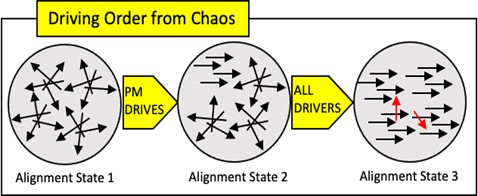The Road to Responsible Collaboration
SERIES ARTICLE
By Robin Hornby
Alberta, Canada
Summary: In this series, Robin Hornby argues that the effectiveness of project management is improved by driving project responsibility into the organization and creating conditions favorable to ‘responsible collaboration’. But this collaborative environment will not fall naturally into place without the support of senior management and the adoption of enabling frameworks, guidelines, and techniques. In this second article we explore the concept of alignment, specific techniques the project manager can apply to achieve it, and the benefits it can bring in addition to the promise of enabling productive owner/provider engagement.
Introduction
Alignment is an enabler of collaborative engagement, where major productivity gains are to be found. I hesitate to call it a prerequisite because project management (PM) is not a science. But because a well-aligned project enjoys benefits, it’s a legitimate goal for the project manager (the PM) to pursue in any case.
The degree of benefit is dependent on the degree of alignment. The diagram, Driving Order from Chaos, provides a visual for a dilemma familiar to PMs at the beginning of every complex project. The objective, of course, is to have everyone ‘pointing in the same direction’.
The skilled PM can do much to create this. Project team alignment is a classic starting point because dealing with unmotivated team members who believe the project is either ill-conceived or technically misdirected present an immediate problem. A greater challenge is misaligned stakeholders who disagree with the project justification or its basic objectives and can delay the project or even threaten its feasibility. And business alignment is so significant I will devote a complete future article to it.

A good leader knows an essential part of the role is to build unity of purpose while facing legitimate diversity of opinion. Before turning to helpful techniques, I should acknowledge leadership style helps deal with these challenges, and versatile behavior will allow direction appropriate to the circumstances to be adopted; sometimes consensus-driven, sometimes democratic, and sometimes dictatorial. A touch of charisma can also help!
Rules and Techniques
While working on our charisma, there are some concrete rules and techniques to complement the PM’s ‘soft’ skills. Here are six construed from discussion on alignment in my earlier book Ten Commandments of Project Managment1 and should move the project from alignment state 1 to at least state 2:
- Make Tasks Meaningful: Expand project objectives into deliverables and activities so work assignments can be traced and identified as relevant and meaningful.
- Attend to Personal Objectives: A dynamic approach is to align assignments with a team member’s or stakeholder’s personal objectives to create a ‘win-win’. Or as King Ferdinand II allegedly said, “He serves his king the best who also serves himself”.
- Manage Owner Expectations: Keep sponsor and stakeholder expectations in line with forecast results. A cliché maybe, but PM action is still required. Some ideas:
More…
To read entire article, click here
Editor’s note: This series of articles is by Robin Hornby, author of four books including A Concise Guide to Project Collaboration: Building a Delivery Organization (Routledge 2023) and Ccommercial Project Management: A Guide for Selling and Delivering Professional Services (Routledge 2017). Learn more about the author in his profile below.
How to cite this article: Hornby, R. (2023). Part 2 Strive for Alignment, The Road to Responsible Collaboration, series article, PM World Journal, Vol. XII, Issue VI, June. Available online at https://pmworldlibrary.net/wp-content/uploads/2023/05/pmwj130-Jun2023-Hornby-strive-for-alignment-collaboration-series-2.pdf
About the Author

Robin Hornby
Alberta, Canada
![]()
Robin Hornby worked in Information Technology for over 40 years, taught project management at Mount Royal University for 12 years and maintained a consulting practice. He worked across Canada and internationally, was a long-time holder of the PMP designation, and presented frequently at PMI symposia. He pioneered many delivery management practices and is the author of four books. His latest book titled A Concise Guide to Project Collaboration: Building a Delivery Organization was published in 2023 by Routledge. For more information, visit www.tmipm.com. Robin Hornby can be contacted at rchornby@shaw.ca









